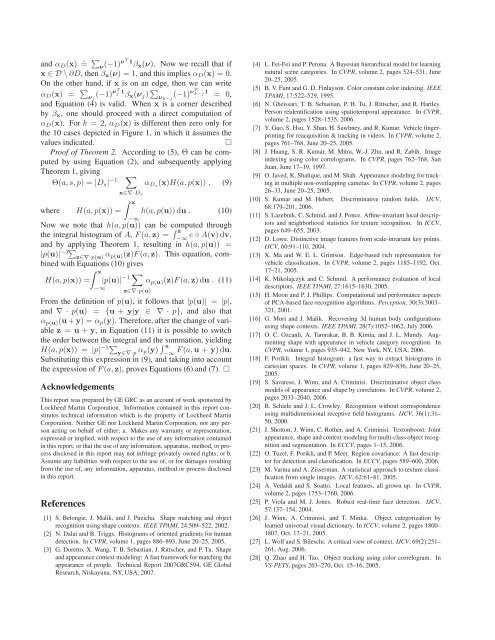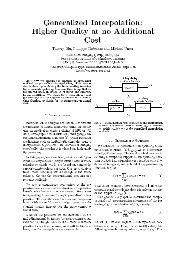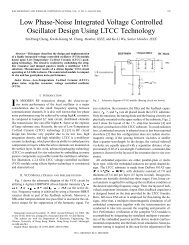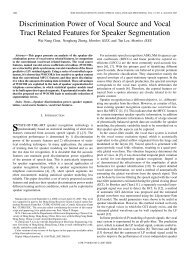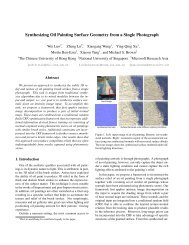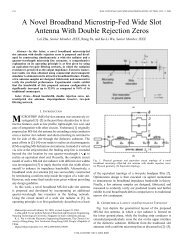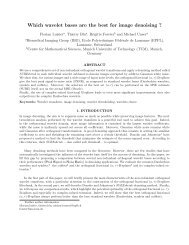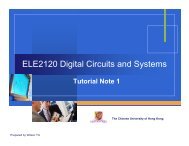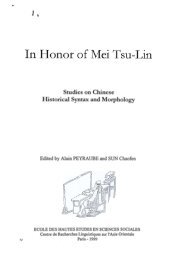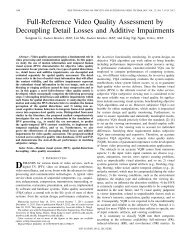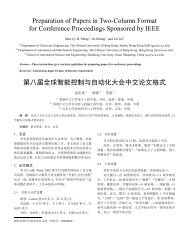Shape and Appearance Context Modeling - UCLA Vision Lab
Shape and Appearance Context Modeling - UCLA Vision Lab
Shape and Appearance Context Modeling - UCLA Vision Lab
Create successful ePaper yourself
Turn your PDF publications into a flip-book with our unique Google optimized e-Paper software.
<strong>and</strong> α D (x) = . ∑ ν (−1)νT1 β x (ν). Now we recall that ifx ∈ D \ ∂D, then β x (ν) = 1, <strong>and</strong> this implies α D (x) = 0.On the other h<strong>and</strong>, if x is on an edge, then we can writeα D (x) = ∑ ν j(−1) νT j 1 β x (ν j ) ∑ ν k−j(−1) νT k−j 1 = 0,<strong>and</strong> Equation (4) is valid. When x is a corner describedby β x , one should proceed with a direct computation ofα D (x). For k = 2, α D (x) is different then zero only forthe 10 cases depicted in Figure 1, in which it assumes thevalues indicated.□Proof of Theorem 2. According to (5), Θ can be computedby using Equation (2), <strong>and</strong> subsequently applyingTheorem 1, givingΘ(a, s, p) = |D s | −1where H(a, p(x)) =∑x∈∇·D sα Ds (x)H(a, p(x)) , (9)∫ x−∞h(a, p(u))du . (10)Now we note that h(a, p(u)) can be computed throughthe integral histogram of A, F(a,z) = ∫ z−∞ e ◦ A(v)dv,<strong>and</strong> by applying Theorem 1, resulting in h(a, p(u)) =|p(u)| −1∑ z∈∇·p(u) α p(u)(z)F(a,z). This equation, combinedwith Equations (10) gives∫ xH(a, p(x)) = |p(u)| ∑ −1 α p(u) (z)F(a,z)du . (11)−∞z∈∇·p(u)From the definition of p(u), it follows that |p(u)| = |p|,<strong>and</strong> ∇ · p(u) = {u + y|y ∈ ∇ · p}, <strong>and</strong> also thatα p(u) (u +y) = α p (y). Therefore, after the change of variablez = u + y, in Equation (11) it is possible to switchthe order between the integral <strong>and</strong> the summation, yieldingH(a, p(x)) = |p| −1∑ y∈∇·p α p(y) ∫ xF(a,u + y)du.−∞Substituting this expression in (9), <strong>and</strong> taking into accountthe expression of F(a,z), proves Equations (6) <strong>and</strong> (7). □AcknowledgementsThis report was prepared by GE GRC as an account of work sponsored byLockheed Martin Corporation. Information contained in this report constitutestechnical information which is the property of Lockheed MartinCorporation. Neither GE nor Lockheed Martin Corporation, nor any personacting on behalf of either; a. Makes any warranty or representation,expressed or implied, with respect to the use of any information containedin this report, or that the use of any information, apparatus, method, or processdisclosed in this report may not infringe privately owned rights; or b.Assume any liabilities with respect to the use of, or for damages resultingfrom the use of, any information, apparatus, method or process disclosedin this report.References[1] S. Belongie, J. Malik, <strong>and</strong> J. Puzicha. <strong>Shape</strong> matching <strong>and</strong> objectrecognition using shape contexts. IEEE TPAMI, 24:509–522, 2002.[2] N. Dalai <strong>and</strong> B. Triggs. Histograms of oriented gradients for hum<strong>and</strong>etection. In CVPR, volume 1, pages 886–893, June 20–25, 2005.[3] G. Doretto, X. Wang, T. B. Sebastian, J. Rittscher, <strong>and</strong> P. Tu. <strong>Shape</strong><strong>and</strong> appearance context modeling: A fast framework for matching theappearance of people. Technical Report 2007GRC594, GE GlobalResearch, Niskayuna, NY, USA, 2007.[4] L. Fei-Fei <strong>and</strong> P. Perona. A Bayesian hierarchical model for learningnatural scene categories. In CVPR, volume 2, pages 524–531, June20–25, 2005.[5] B. V. Funt <strong>and</strong> G. D. Finlayson. Color constant color indexing. IEEETPAMI, 17:522–529, 1995.[6] N. Gheissari, T. B. Sebastian, P. H. Tu, J. Rittscher, <strong>and</strong> R. Hartley.Person reidentification using spatiotemporal appearance. In CVPR,volume 2, pages 1528–1535, 2006.[7] Y. Guo, S. Hsu, Y. Shan, H. Sawhney, <strong>and</strong> R. Kumar. Vehicle fingerprintingfor reacquisition & tracking in videos. In CVPR, volume 2,pages 761–768, June 20–25, 2005.[8] J. Huang, S. R. Kumar, M. Mitra, W.-J. Zhu, <strong>and</strong> R. Zabih. Imageindexing using color correlograms. In CVPR, pages 762–768, SanJuan, June 17–19, 1997.[9] O. Javed, K. Shafique, <strong>and</strong> M. Shah. <strong>Appearance</strong> modeling for trackingin multiple non-overlapping cameras. In CVPR, volume 2, pages26–33, June 20–25, 2005.[10] S. Kumar <strong>and</strong> M. Hebert. Discriminative r<strong>and</strong>om fields. IJCV,68:179–201, 2006.[11] S. Lazebnik, C. Schmid, <strong>and</strong> J. Ponce. Affine-invariant local descriptors<strong>and</strong> neighborhood statistics for texture recognition. In ICCV,pages 649–655, 2003.[12] D. Lowe. Distinctive image features from scale-invariant key points.IJCV, 60:91–110, 2004.[13] X. Ma <strong>and</strong> W. E. L. Grimson. Edge-based rich representation forvehicle classification. In CVPR, volume 2, pages 1185–1192, Oct.17–21, 2005.[14] K. Mikolajczyk <strong>and</strong> C. Schmid. A performance evaluation of localdescriptors. IEEE TPAMI, 27:1615–1630, 2005.[15] H. Moon <strong>and</strong> P. J. Phillips. Computational <strong>and</strong> performance aspectsof PCA-based face-recognition algorithms. Perception, 30(3):3003–321, 2001.[16] G. Mori <strong>and</strong> J. Malik. Recovering 3d human body configurationsusing shape contexts. IEEE TPAMI, 28(7):1052–1062, July 2006.[17] O. C. Ozcanli, A. Tamrakar, B. B. Kimia, <strong>and</strong> J. L. Mundy. Augmentingshape with appearance in vehicle category recognition. InCVPR, volume 1, pages 935–942, New York, NY, USA, 2006.[18] F. Porikli. Integral histogram: a fast way to extract histograms incartesian spaces. In CVPR, volume 1, pages 829–836, June 20–25,2005.[19] S. Savarese, J. Winn, <strong>and</strong> A. Criminisi. Discriminative object classmodels of appearance <strong>and</strong> shape by correlatons. In CVPR, volume 2,pages 2033–2040, 2006.[20] B. Schiele <strong>and</strong> J. L. Crowley. Recognition without correspondenceusing multidimensional receptive field histograms. IJCV, 36(1):31–50, 2000.[21] J. Shotton, J. Winn, C. Rother, <strong>and</strong> A. Criminisi. Textonboost: Jointappearance, shape <strong>and</strong> context modeling for multi-class object recognition<strong>and</strong> segmentation. In ECCV, pages 1–15, 2006.[22] O. Tuzel, F. Porikli, <strong>and</strong> P. Meer. Region covariance: A fast descriptorfor detection <strong>and</strong> classification. In ECCV, pages 589–600, 2006.[23] M. Varma <strong>and</strong> A. Zisserman. A statistical approach to texture classificationfrom single images. IJCV, 62:61–81, 2005.[24] A. Vedaldi <strong>and</strong> S. Soatto. Local features, all grown up. In CVPR,volume 2, pages 1753–1760, 2006.[25] P. Viola <strong>and</strong> M. J. Jones. Robust real-time face detection. IJCV,57:137–154, 2004.[26] J. Winn, A. Criminisi, <strong>and</strong> T. Minka. Object categorization bylearned universal visual dictionary. In ICCV, volume 2, pages 1800–1807, Oct. 17–21, 2005.[27] L. Wolf <strong>and</strong> S. Bileschi. A critical view of context. IJCV, 69(2):251–261, Aug. 2006.[28] Q. Zhao <strong>and</strong> H. Tao. Object tracking using color correlogram. InVS-PETS, pages 263–270, Oct. 15–16, 2005.


